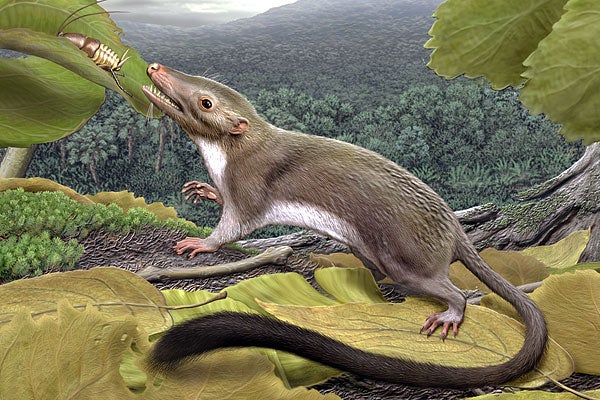
Our furry, scampering common ancestor
Published: February 7, 2013
A massive international research collaboration says the common ancestor of placental mammals - a group that includes humans - was a scampering, insect-eating creature that appeared after the extinction of the dinosaurs.
The University of Toronto Scarborough's Mary Silcox, assistant professor of anthropology, was part of the team that reconstructed the family tree of placental mammals – a diverse group that includes cats, dogs, horses and humans. Their research traces placental mammals back to a tiny, furry creature that got its start 200,000 years or more after the extinction of the dinosaurs.
The work is featured in this week’s Science magazine (read more here and here.)
Silcox, assistant professor of anthropology at UTSC, is a co-author on the paper and the only Canadian member of the team. She was responsible for organizing the dental traits used in the analysis and contributed to the collection of the data that were used to classify primates, including humans.
“We were responsible for putting humans in the tree of life,” said Silcox, referring to her work with Jonathan Bloch of the Florida Museum of Natural History and Eric Sargis of Yale University.

The research team used the world’s largest dataset combining genetic and physical traits to reconstruct the placental mammal tree of life. A major finding is that placental mammals diversified much later than previous theories had suggested, with all of the major groups alive today originating after the extinction of the dinosaurs. Genetic evidence alone had suggested that placental mammals were already a diverse group in the Late Cretaceous period, before the event that drove the dinosaurs and 70 percent of other then-existing species extinct.
But by adding evidence from fossils, the team concluded that placental mammals arose a few hundred thousand years after the extinction event.
Silcox’s team also looked at the question of which mammals are most closely related to primates – the flying lemurs or the treeshrews, both found in Southeast Asia. Their evidence shows that primates are equally close to both.
To carry out the study, the researchers built a database that recorded physical – or phenomic – traits for 86 placental mammal species, including 40 species that are extinct and known only from fossils. More than 4,500 traits, including the presence or absence of wings, teeth, and certain bone types, were recorded in the database and used to construct the tree of life, in combination with genetic data.
More than 1,400 of those traits were based on teeth, and Silcox led the team that decided which dental traits to include.
“In mammalian paleontology, teeth are the gold standard. They preserve better than anything else,” she said.
The phenomic dataset is 10 times larger than those that had previously been used to study mammal relationships, is publicly available online, and illustrated with over 12,000 images.
Silcox says that the work will serve as a model for future projects that will give us a better idea of how species evolved and are related to one another.
The research was funded by the National Science Foundation, and led by researchers at the American Museum of Natural History and other institutions from the US, Canada, and elsewhere.



